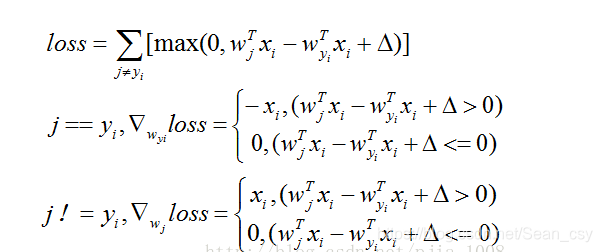A two-layer fully-connected neural network. The net has an input dimension of
N, a hidden layer dimension of H, and performs classification over C classes.
We train the network with a softmax loss function and L2 regularization on the
weight matrices. The network uses a ReLU nonlinearity after the first fully
connected layer.In other words, the network has the following architecture:
input - fully connected layer - ReLU - fully connected layer - softmax
The outputs of the second fully-connected layer are the scores for each class.
本次两层网络的作业难点还是在梯度的计算上,题目要求的两个激活函数分别是ReLu函数和softmax函数。来回顾一下。


对其求导
ReLu
softmax
其中,

运用链式法则,

这里求导要进行分类,当j!=yi 时:

当j==yi时:

在网络中,我们用反向传播算法来求梯度。以下公式来源(https://blog.youkuaiyun.com/yc461515457/article/details/51944683)
前向传播:

反向传播

在明确方法后,开始编写程序。
from __future__ import print_function
import numpy as np
import matplotlib.pyplot as plt
from past.builtins import xrange
class TwoLayerNet(object):
"""
A two-layer fully-connected neural network. The net has an input dimension of
N, a hidden layer dimension of H, and performs classification over C classes.
We train the network with a softmax loss function and L2 regularization on the
weight matrices. The network uses a ReLU nonlinearity after the first fully
connected layer.
In other words, the network has the following architecture:
input - fully connected layer - ReLU - fully connected layer - softmax
The outputs of the second fully-connected layer are the scores for each class.
"""
def __init__(self, input_size, hidden_size, output_size, std=1e-4):
"""
Initialize the model. Weights are initialized to small random values and
biases are initialized to zero. Weights and biases are stored in the
variable self.params, which is a dictionary with the following keys:
W1: First layer weights; has shape (D, H)
b1: First layer biases; has shape (H,)
W2: Second layer weights; has shape (H, C)
b2: Second layer biases; has shape (C,)
Inputs:
- input_size: The dimension D of the input data.
- hidden_size: The number of neurons H in the hidden layer.
- output_size: The number of classes C.
"""
self.params = {
}
self.params['W1'] = std * np.random.randn(input_size, hidden_size)
self.params['b1'] = np.zeros(hidden_size)
self.params['W2'] = std * np.random.randn(hidden_size, output_size)
self.params['b2'] = np.zeros(output_size)
def loss(self, X, y=None, reg=0.0):
"""
输入层(D),全连接层-ReLu(H),softmax(C)
Compute the loss and gradients for a two layer fully connected neural
network.
Inputs:
- X: Input data of shape (N, D). Each X[i] is a training sample.
- y: Vector of training labels. y[i] is the label for X[i], and each y[i] is
an integer in the range 0 <= y[i] < C. This parameter is optional; if it
is not passed then we only return scores, and if it is passed then we
instead return the loss and gradients.
- reg: Regularization strength.
Returns:
If y is None, return a matrix scores of shape (N, C) where scores[i, c] is
the score for class c on input X[i].
If y is not None, instead return a tuple of:
- loss: Loss (data loss and regularization loss) for this batch of training
samples.
- grads: Dictionary mapping parameter names to gradients of those parameters
with respect to the loss function; has the same keys as self.params.
"""
# Unpack variables from the params dictionary
W1, b1 = self.params







 这篇博客详细介绍了两层全连接神经网络的结构,包括输入层、ReLU激活函数、softmax输出层。文章重点讨论了在梯度计算中的分类求导,并引用了反向传播算法来求解网络权重的梯度。作者通过实例解释了如何进行前向传播和反向传播,并提到了超参数调优。文章以一个有趣的比喻总结了反向传播中不同操作对梯度的影响。
这篇博客详细介绍了两层全连接神经网络的结构,包括输入层、ReLU激活函数、softmax输出层。文章重点讨论了在梯度计算中的分类求导,并引用了反向传播算法来求解网络权重的梯度。作者通过实例解释了如何进行前向传播和反向传播,并提到了超参数调优。文章以一个有趣的比喻总结了反向传播中不同操作对梯度的影响。
 最低0.47元/天 解锁文章
最低0.47元/天 解锁文章
















 526
526

 被折叠的 条评论
为什么被折叠?
被折叠的 条评论
为什么被折叠?








